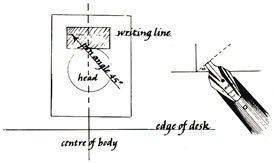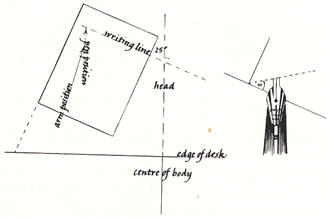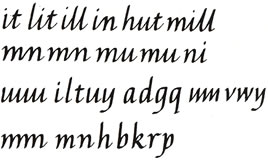Italic Questions and Answers
Brian Walker
Introduction
What I admire most about Alfred Fairbank's A Handwriting Manual is the strength of his underlying philosophy. It isn't simply a 'how to do it' book on handwriting. The good teacher's understanding and command of his subject come through time and time again. At the beginning of his book, Fairbank uses a question from a Robert Bridges' broadcast. It is concerned with the cultivation of beauty, aesthetic sensibility and spiritual things in the young. For all manner of reasons such sensibility does not always blossom and flourish as time goes on, and time could well be the decisive factor. Time to think, explore, enjoy leaming and experiences for their own sake— all those things become lost in the realities of life. Routine takes over. The convergent thought excludes the more leisurely divergent one. Creativity stops at the wrist, and the struggle to recapture early curiosity and discovery through play is not an easy one.
I mention this for, whilst 'handwriting is a functional thing, intended for communication and recording thought,' there are aesthetic elements in its execution which contribute to the final outcome. Manipulative skill, visual and tactile experiences, sensitivity to materials, the technique of analysis all help in the process to improve one's handwriting.
Many common handwriting problems relate to a lack of sensibility of one or more of these elements. Uncorrected bad habits of posture, penhold, paper position on the desk or table add to the difficulties. Out of forty or so adults I taught recently, three-quarters of them sat badly, wrote well outside the line of their bodies and held the pen in a vice-like grip, resulting in much pen-pushing and finger-writing.
Handwriting is one of those everyday activities most of us do automatically and unconsciously, like driving a car. A reaction to engine sound, speed, road conditions, the visual and auditory signals coming in may be described as a 'driving consciousness.' In a similar way, it is possible to acquire a 'hand-writing consciousness.' The teaching of handwriting highlights (or should) a whole range ofconcepts, skills and processes which hitherto may not have been quite so acute. Attention is drawn to the physical act ofwriting, the visual emergence of inky marks, shapes and counterspaces on the writing surface, the sensitivity of pen, ink and paper, the feeling of rhythm and bodily movement, the quiet 'talk' of the pen's conversation with the paper, the emerging pattern of the writing. And once that greater awareness has been nurtured and made perennial, one senses an inward contentment and ease towards the written word and its presentation. Writing becomes a pleasure to give and receive.
Fairbank's little sections on legibility, beauty, unity, speed, freedom and control are worthy to be read and re-read for in those words lie the essence of good handwriting. They encompass the concepts underlying further progress and development. I emphasise that handwriting cannot be learned in a totally practical vacuum. It needs other things too. What none of us may have enough time to do is ponder on such matters and in so doing, make a little improvement step by step with each little shock of recognition.
Posture
I have always been keen on sport, especially cricket and note with interest how the best sportsmen and women work continuously at their technique. The same could be said of dancers. Great batsmen or golfers or ballerinas are never careless about their stance and the position of one part of the body in relationship to the rest. I believe that this principle applies to mastering the techniques of handwriting too, and use the analogy in my teaching. The more correctly we sit in order to write, the more handwriting is likely to improve. It is a good idea to use a check-list about posture before starting to write, perhaps in the same way that a golfer spends time in addressing the ball before hitting it or to use another idea, in the same way the pilot checks his aircraft before taking-off down the runway.
Checklist — a general guide for individual differences
- Sit at the back of the chair and lean slightly forward without stooping and without the chest touching the edge of the desk.
- Shoulders should be parallel to the desk. Twisting the body should be avoided.
- Forearms should rest lightly on the desk pointing slightly diagonally inwards towards the writing position. Both sides ofthe body should be symmetrical.
- Feet should be placed on the floor in front of the chair. This will aid balance and comfort. Many children place their feet backwards or wrap them round the chair legs. Logically, leaning forward when seated and putting the legs and feet backwards would cause one to fall flat on one's face were it not for the arms leaning on the table and propping up the body. The arms are needed for writing and should not be restricted by having to support the weight of the body.
- Elbows should be away from the sides of the body, but not excessively so. Placing the 'writing elbow' against the side of the body is to be avoided. Both extremes change the pen-angle from 45°, and the latter causes the wrist to rest uncomfortably on the edge of the desk, restricting free movement.
- The head should be held level, with the eyes at a safe distance from the paper.
- The left hand (or non-writing hand) should hold the paper under (and not over) the writing line, moving with the writing hand at intervals and acting as a counter-balance. I prefer to rest two parallel fingers on the paper rather than the whole hand. (My children call this the 'dib, dib, dob,dob' position for obvious reasons).
- The writing paper should lay central to the body and paralleI to the edge of the desk. Slanting the paper is a common fault and causes the rest of the check-list to become null and void, altering virtually everything else, particularly pen-angle. When writing on A4 paper, I find it useful to move the paper once to the left during the course of writing a line. Rhythm, movement and consistency of slope will be maintained if one imagines writing through a letter box — directly in front of oneself

Left-handers
The check-list for left-handers contains a number of opposites to those described above. Whilst advocating the usual advice given abour posture and paper position for left-handers, I adopt one or two slight variations. These have emerged through teaching an unusually large proportion of left-handers at school over the past twelve months, seeking advice from left-handed teachers and practising left-handed myself. When teaching left-handed people, I always make a point of doing any demonstration left-handedly. This helps both them to understand and me to to appreciate the principles involved. What I always say to the left-hander is There are no problems. Your hand is as natural as mine, so avoid worrying abour not being able to write italic with an edged pen.
Left-hander's check-list
Follow 1,2,3,4,6, as for right-handers with the following adjustments:
- In 3, pull the left elbow in more towards the body, so that the arm is more straight than diagonal, but not excessively so.
- In 6, lean the head slightly to the right (it seems to work).
- In 7, the right hand should hold the paper on the right-hand side and well below the on-coming left hand as it travels across the page. This should avoid a clash of hands about halfway across the page.
- In 8, the writing paper should lie outside the line of the body, the right/top corner tilted downwards. The amount of tilt should be governed by the angle of the left oblique nib at 45° to the writing-line, the left arm almost parallel with the left-hand edge of the paper and the pen-shaft pointing more or less at the shoulder. As a rough guide, I would say that the paper might be tilted about 25° or 30° from the straight
position.
The whole aim for the left-hander is to avoid pushing.

Pen-hold
Take a pen and hold it normally for writing. Pull the fingers holding the pen sharply back into the palm and grip the pen as tightly as possible. Now feel the fleshy muscle underneath the forearm just below the elbow. It is hard and tense. Now relax the grip and push the fingers and thumb from the palm. Relax the hand, wrist and arm right through to the shoulder. Roll the pen around playfully in the fingers. If you now feel the same arm-muscle, you will notice how soft and relaxed it is.
Make an up-and-clown movement with the pen like this ↑ ↓ . Do it several times without touching the paper; just hover over it. Now make contact with the paper, a steady up-and-down movement. Stop when the hand feels awkward or begins to feeI tense again.
Just scribble with a slight forward tilt. 
Notice how easy it is to move slowly across the page using this controlled scribble. Try it with your eyes closed, just feeling the hand's rhythmical movement. Speed up, slow down. Avoid undue pressure on the nib. Let the pen do the work. Pressure and friction make writing more difficult.
Concentrate on the movement and sense the ease with which the pen moves in contact with the surface. Now with a slight change, put an anti-clockwise movement at the bottom of the zig-zag.

Reverse the procedure and put a clockwise movement at the top.

Alter the movement at random until you can control it at will.

Quite a number of right-handed writers tend to pull the fingers into the palm and write with a lot of finger-and-thumb movement. The extension of the fingers away from the palm in order to relax the whole process of writing, keeping the thumb still, especially at the joint, and allowing the index finger to take control should avoid some of the usual problems.
The left-hander may in fact fmd it beneficial to use more thumb action to facilitate a pull to the left and acquire a forward slope to the writing. It may also help to turn the wrist slightly so that the two Aeshy parts at each side of the base of the hand rest on the paper instead of the edge of the hand adjacent to the little finger more appropriate to right-handed writers.
The zig-zag scribble I teach fairly early on moves naturally into a clockwise or anti-clockwise movement and pattern and these two movements in tum produce the majority ofletters. The anti-clockwise movement also plays a significant part injoining letters together. Perhaps those italicists still trying to improve their style might be helped by spending time just enjoying the three patterns mentioned here and then relating them to specific letters, joins and words.

Adding the next pattern helps understanding of the oval o and the concept of horizontal joins.

In many handwriting schemes, one can find all manner of writing patterns. Apart from two adaptations of the clockwise and anti-clockwise patterns:  I only use the ones illustrated here, i.e. four patterns to produce twenty-one letters of the alphabet including joins. Simplicity and economy are the essence of a structured process and certainly leads to less confusion.
I only use the ones illustrated here, i.e. four patterns to produce twenty-one letters of the alphabet including joins. Simplicity and economy are the essence of a structured process and certainly leads to less confusion.
 are simply taught as separate letters although I usually relate
are simply taught as separate letters although I usually relate  with
with  and
and  with
with 
My own handwriting is written at approximately 120 letters per minute which I find more than adequate for most purposes.
Conclusion
The four main teaching points in trus article may be summarised thus:
- Handwriting is more than a mechanical activity. Any improvement must depend on a thorough understanding of the whole essence of the italic hand and the analysis of the principles involved. Aesthetic elements are important.
- Posture is important and should be considered seriously as an integral part of handwriting success.
- Relaxation should be practised as a means to achieving an easy 'dance of the pen.' Poor pen-hold can adversely affect the marks being made.
- Writing-patterns help to provide the essential hand-movements which lead naturally into correct letter-shapes and joins, but at the same time, assist flow and speed. Maturity in writing-style develops with freedom and confidence.
Perhaps more attention might be devoted to points 1, 2 and 3 in any future handwriting schemes.
